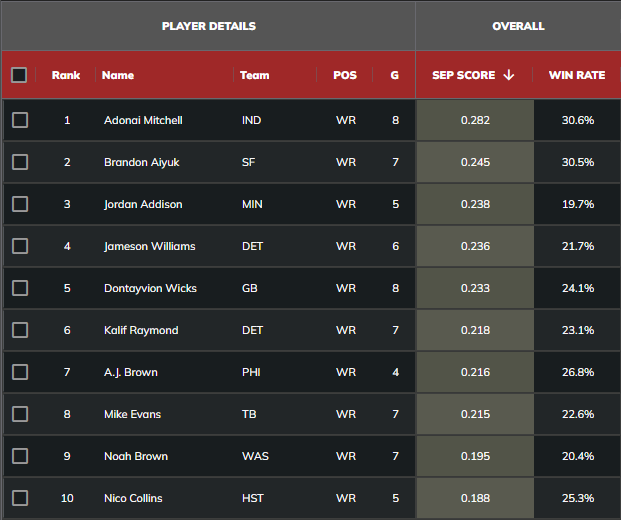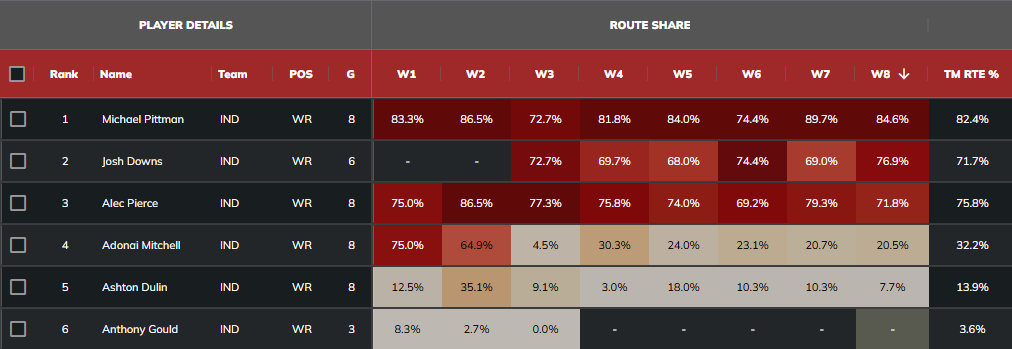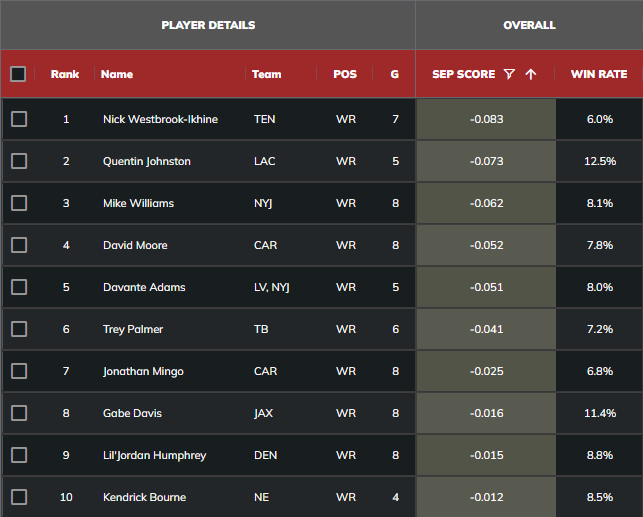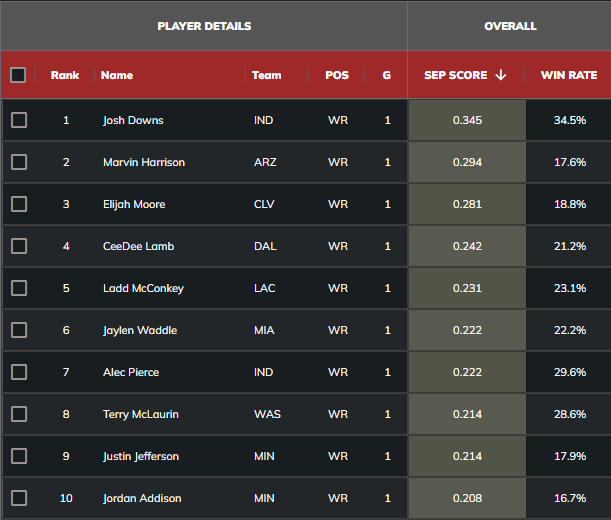Every week I will be diving into the Fantasy Points Data to provide our readers with actionable and winning insights into your season. This week provided a lot of valuable data points for things going forward and showcased some of the major improvements players have made. I will focus mainly on ASS (Average Separation Score) but blend in plenty of metrics that offer a full picture, like first-read targets.
If you are new to the term ASS don’t worry — we have covered the ASS metric in great detail with What's the deal with ASS? and Our ASS Sleepers and Breakouts.
Top ASS Overall
(Minimum 75 routes run)
This week's *A.S.S. Report* focuses exclusively on rookie wide receivers. This class has been exceptional, with impressive performances across the board. I’ll cover players from the top to the bottom, showcasing both early stars and those still finding their footing. Not long ago, rookie seasons were primarily developmental, but today’s breakout players have raised expectations. However, not every rookie can be a Ja'Marr Chase — some may follow a longer path, like Chris Godwin’s, or reach a solid but not elite level, similar to Emmanuel Sanders.
Top 5 Rookie A.S.S. Overall
(Minimum 75 routes run)
Adonai Mitchell (IND)
Mitchell has performed at a high level, leading the NFL in A.S.S. Score this season. However, strong performance metrics don't matter much if he’s not consistently on the field. So far, he’s only had two meaningful weeks in route share, both in the absence of Josh Downs.
The move to Joe Flacco could improve Mitchell’s production potential, especially since Anthony Richardson led the league with a 28.6% off-target throw rate. For a player barely hitting a 20% route share, creating big plays with such inconsistent QB accuracy is challenging. Despite this, Mitchell is excelling in his limited opportunities, with a 37% win rate on horizontal routes and a 25% win rate on vertical routes. Unfortunately, these stats have little impact if he’s not on the field consistently.
Mitchell is still developing, but he possesses all the traits to be a playmaker at the NFL level—it’s just a matter of patience. While he has the potential to be a high-impact player, it's clear he's not yet playing ahead of Alec Pierce, for reasons we’re not knowledgeable to. Sometimes, stepping back to refine one’s craft can lead to a stronger long-term role. Given Michael Pittman Jr.'s recent performance, it wouldn’t be surprising to see Mitchell earn more playing time, allowing Pittman to rest while Mitchell showcases his big-play ability.
Luke McCaffrey (WAS)
McCaffrey stands out in the yearly A.S.S. Metric, but his high score is partly due to limited playing time and strategic slot usage, which tends to elevate scores. Still, McCaffrey has clear talent and benefits from working with a quarterback who’s off to an elite start. I like McCaffrey’s game, but he’s gotta develop a game outside so that he can perform at a high level. Again, not going to be a factor much for this season, but the film and data show he’s got talent, and he’s growing as a player. Noah Brown, whom I highlighted in last week's A.S.S. Report , is performing well and recently delivered that memorable, game-winning touchdown. I don’t think McCaffrey deserves more play time over Brown at the moment.
Ladd McConkey (LAC)
McConkey has been outstanding this season, posting a 21.1% win rate and an A.S.S. score of 0.149 while establishing himself as Herbert’s primary target. One encouraging trend for McConkey is the Chargers’ increased pass volume since the bye week, likely due to Herbert’s improved ankle condition. Over the last three games, the Chargers have averaged 35 pass attempts per game, a volume that should translate into more opportunities and production for McConkey.
WR Ladd McConkey, Georgia.
— Jordan Vanek (@JordanVanekDFS) March 8, 2024
McConkey was targeted more out wide than in the slot throughout his college career. He is not a "slot" WR.
He averaged over 2.0 yards per route run from both alignments and when you watch him play, you see why.
His 4.39 speed is more than just a… pic.twitter.com/xM8u8eUtGD
Impressively, the skills he displayed in college — particularly his ability to win out wide — have translated well to the pros. In fact, McConkey’s win rate and separation score are even higher when he lines up outside than when he’s in the slot. This adaptability makes him a key asset in the Chargers' passing game, with a promising trajectory as they continue to lean on a more pass-heavy offense.
Malik Nabers (NYG)
The most impressive aspect of Nabers’ performance is his negative rate of under 10%, despite consistently facing the opposing team’s top cornerback as the Giants' clear-cut WR1. Nabers has already established himself as one of the league’s standout talents, and with stronger offensive line and quarterback play, he’d likely reach elite production levels. For now, a 33% target per route rate and a 2.26 yards per route run rate will have to be the baseline.
WR Malik Nabers, LSU
— Jordan Vanek (@JordanVanekDFS) March 27, 2024
Nabers just destroyed his testing on his pro day.
4.38 40
42" Vertical
10'9" broad
Matching everything we see in the college tape. He averaged over 2.8 yards per route run out wide and in the slot.
He averaged over 2 yards per route run on each… pic.twitter.com/aP1vKZFG2v
Nabers is a unique blend of DJ Moore and Calvin Ridley, combining the best qualities of both playmakers. In fact, he’s the best of both of these wide receivers and is already amongst the elite WRs. This is further highlighted by his 46.2% first-read share — only Cooper Kupp and A.J. Brown share that range with him this season.
Brian Thomas Jr. (JAX)
Thomas' injury is an unfortunate setback in what has been an impressive rookie season, but hopefully, he won’t miss too much time (if any) and can return to full strength. He’s already proven himself as an elite deep threat, posting a 24% win rate and an impressive 4.20 yards per route run on vertically breaking routes. Thomas can go toe-to-toe with the NFL's top deep receivers, but to elevate into the elite tier, he’ll need to improve his performance on horizontally breaking routes. Among rookies, he ranks last in win rate on these routes, reflected in his 0.02 A.S.S. score.
While Thomas isn’t yet in the class of Malik Nabers or Marvin Harrison Jr., he’s showing strong potential to reach that level. Given his current situation, he’s the most promising bet to develop into an all-around playmaker.
Overall Bad ASS
(Minimum 75 routes run)
Instead of focusing on the "Bad Asses," I’ll review the rookies with lower A.S.S. scores through the first 8 weeks. Although these players haven’t delivered strong performances yet, their careers are far from over. Their current challenges may not entirely be their fault, and many of them are still developing within their roles.
Bottom 5 Rookie A.S.S. Overall
(Minimum 75 routes run)
Rome Odunze (CHI)
Odunze’s low placement on the list isn’t a reflection of his talent — rather, it highlights the limitations of Shane Waldron’s offensive design and play-calling this season. DJ Moore recently shared that the team isn’t scripting its opening drives—something that could give rookies like Caleb Williams and Odunze more straightforward, scripted plays to help them settle in. It’s surprising they’re not providing this type of support, especially for a young offense. We know Waldron hasn’t been a beloved OC when former Waldron rookie WR Jaxon Smith-Njigba hinted at this frustration during Super Bowl weekend. Furthermore, Odunze faces the added challenge of competing for targets behind two of the league’s top receivers, limiting his opportunities to showcase his abilities, and both of them aren’t really producing high-level numbers themselves.
Odunze’s resilience is commendable. He’s been playing through an MCL sprain sustained in the opener against the Titans, and he hasn’t missed any games. One particularly encouraging stat underscoring his talent is his 34% win rate against man coverage this season. While zone coverage has posed some challenges, his strong performance against man coverage suggests a high ceiling. With a better grasp of zone schemes and improved chemistry with his quarterback, Odunze has the potential to excel.
Though a breakthrough this season seems unlikely under Waldron’s play-calling, Odunze at least benefits from consistent playing time—something Jaxon Smith-Njigba struggled to secure. Odunze is on a promising path to becoming a solid receiver, though it may take a coaching change to fully unlock his potential.
Xavier Worthy (KC)
Since the bye week, Worthy has earned target shares of 29.6% and 21.1% in this offense, and it feels like only a matter of time before Mahomes finds his rhythm, sparking a more consistent offensive performance. Worthy has already had several deep-play opportunities, though Mahomes has just missed him by a few feet on several occasions. Over the last two weeks, Worthy has shown promising signs of improvement, reducing his negative win rate to 5.9% and increasing his positive win rate to 19.6%, indicating that he’s on a solid trajectory.
On Xavier Worthy, don't really care about press. Only need to hit this once a game. Hit the OPEN target please. pic.twitter.com/3fHtY7nUMS
— JetPack Galileo (@JetPackGalileo) October 23, 2024
The Chiefs have adjusted their approach by isolating Worthy more on the outside. His speed has defenders wary, and he’s beginning to capitalize on shorter routes in these situations. Out wide, he’s posted a win rate of 21.9% over the past two weeks, showcasing his ability to adapt and succeed in different areas of the field.
While the original plan was to have Rashee Rice lead this receiving corps, his absence has shifted more responsibility to Worthy and Kelce, who are now the primary playmakers until DeAndre Hopkins fully integrates into the offense. This combination of targets could prove effective as Worthy continues to develop chemistry with Mahomes and evolve within the Chiefs' offensive system.
Jalen McMillan (TB)
McMillan posted an impressive 21.3% first-read target share in a one-game sample without Chris Godwin. However, he played out wide on 71.4% of his routes — a role that doesn’t quite match his strengths. While McMillan can hold his own on the outside, he would likely be far more effective in a complementary role with Mike Evans on the field. As it stands, he might not provide the high-floor consistency in PPR formats that he could if positioned in the slot for most of his reps.
The initial plan seemed to slot McMillan as an outside receiver alongside Evans and Godwin, without any significant slot reps expected while they remained healthy. Ideally, he’d step into some of the responsibilities Godwin handled, but it’s uncertain if the team will pivot that way. Based on current usage, Cade Otton appears to be the key player to watch moving forward, showing strong potential to step up and fill critical gaps in the offense.
Keon Coleman (BUF)
Keon Coleman doesn’t yet excel at creating separation and likely won’t reach a high level in that area for a few years in the NFL. However, what he does bring to the table is his ability to win at the catch point, even when well-covered—a skill he’s demonstrated effectively over the past two weeks. With Josh Allen as his quarterback, Coleman has shown he can produce enough to be impactful, though he may not yet offer consistent fantasy value.
Keon Coleman is too funny. Catches the fade and then says "good rep" to Riq Woolen. pic.twitter.com/Auh3keaO9q
— Nate Tice (@Nate_Tice) October 28, 2024
With the complementary weapons around him, the team is well-positioned to thrive as Cooper fully acclimates with the playbook. In 11 personnel sets featuring Coleman, Shakir, Cooper, and Kincaid, the offense gains a mix of separation skills that can open up the field, with Coleman often drawing one-on-one matchups on the outside. Allen has already shown confidence in Coleman’s ability to make contested catches, giving him big-play potential in critical moments.
Coleman’s physicality as a blocker further cements his role, making him more versatile than Mack Hollins or Shakir, who typically plays in the slot. This ability to contribute in multiple ways has led to a steady increase in his playing time, with his snap share rising above 75% over the last two weeks. With his dual ability to block and make plays downfield, Coleman is becoming a valuable asset in the team’s offensive scheme. I do not think Coleman will be a top fantasy WR in the intermediate future, but he will have some good weeks like we have seen recently.
Xavier Legette (CAR)
Legette is now the primary target in the Panthers’ offense, setting up a steep learning curve in a challenging environment. I’ve always seen Legette as a two-year project, so some growing pains are to be expected. However, the immediate issues are hard to ignore: Bryce Young has struggled, often failing to connect with Legette even when he gets open.
Additionally, play-caller Dave Canales has had a rough stretch, possibly due to the Panthers’ talent limitations, but his recent performance hasn’t helped matters. Facing the Saints this weekend could add another layer of difficulty for Legette and the offense.
Notable Weekly ASS
(Minimum 20 routes run)
Notable Rookie WRs
Ricky Pearsall (SF)
Just months after a traumatic injury, he looked solid in his outing against Dallas. While he hasn’t been dominant, his 15.1% win rate and nine targets over his first two NFL games are impressive, especially considering what he’s overcome.
However, I don’t expect him to take on a significant role or become a highly productive receiver this season. We saw Brandon Aiyuk occasionally hit a 30% target share last year, but with McCaffrey rumored to return soon, Pearsall’s opportunities will likely be limited behind established playmakers like Kittle and Deebo. Additionally, Jauan Jennings has carved out a role this season, which could further impact Pearsall's route share. For now, he’s off to a promising start but may need more time and a more straightforward path to volume before making a big impact.
Summarized
Among the rookies, there are a few standouts, Adonai Mitchell (IND) shows promise but needs more playing time to fully break out, while Luke McCaffrey (WAS) benefits from slot usage but must expand his skill set to remain impactful. Ladd McConkey (LAC) has adapted well to an increased pass-heavy offense, making him a reliable option for Justin Herbert and explosive weeks. Malik Nabers (NYG) continues to thrive, posting an elite first-read target share, while Brian Thomas Jr. (JAX) has excelled as a deep threat, though he’ll need to improve his horizontal game.
On the lower end, Rome Odunze (CHI) struggles within a limited offensive scheme, showing potential against man coverage but needing better support to develop. Xavier Worthy (KC) has gained opportunities post-bye week, with Mahomes starting to connect more consistently. Keon Coleman (BUF) stands out for his contested-catch ability and versatility, though he’s still learning separation. Overall, these rookies show potential for strong fantasy impact, with many players on promising developmental paths.











